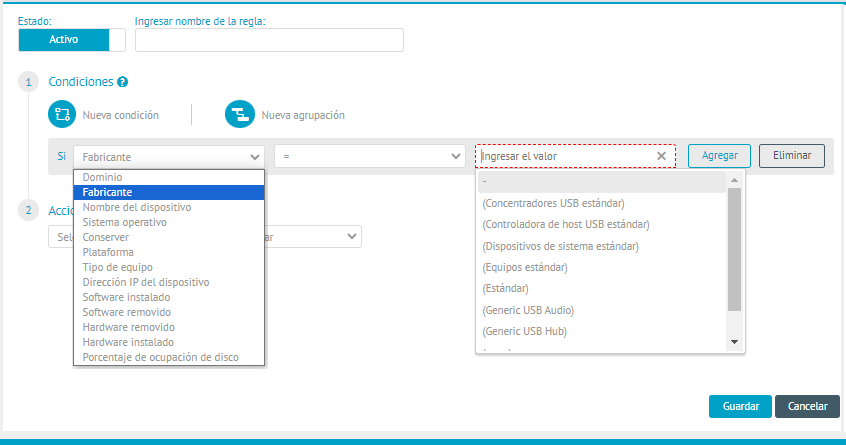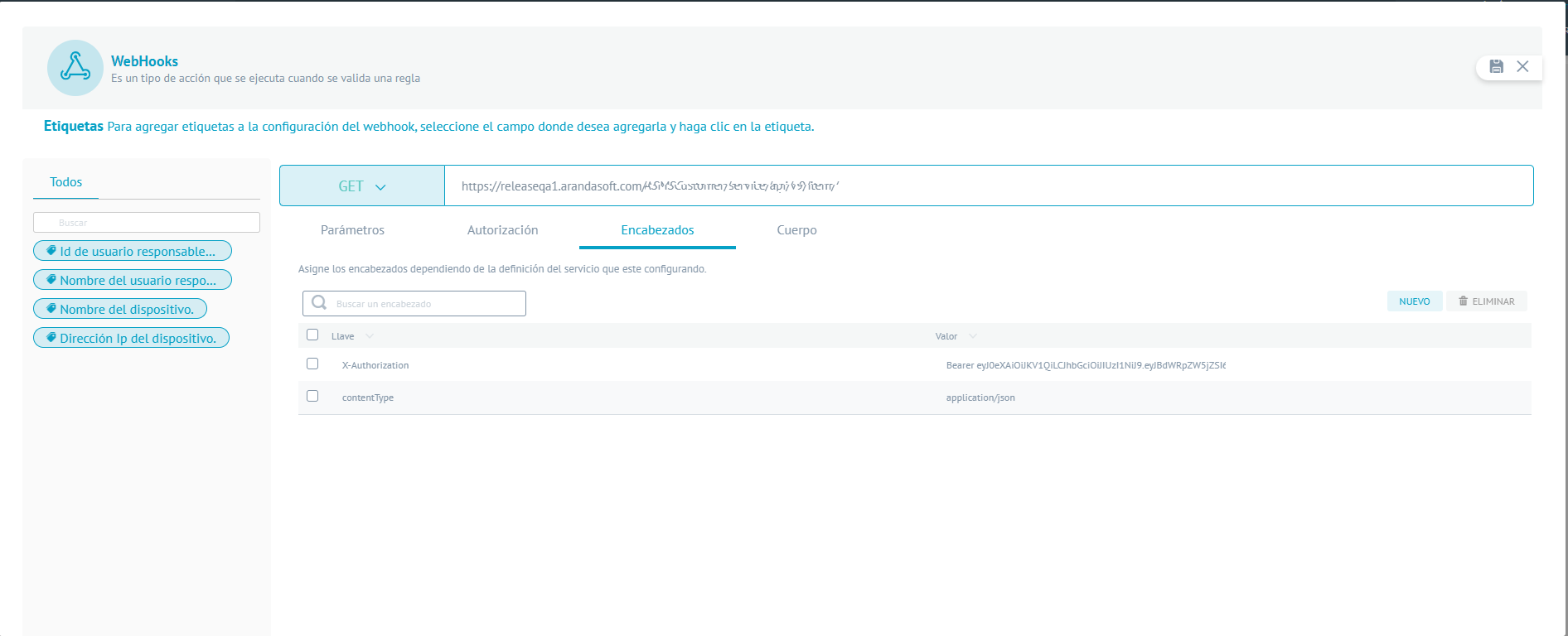The rules in ADM of type update, discovery, and devices will be composed of the following criteria:

Basic Facts
1. Basic rule information such as name and status (Active/Inactive).
Conditions
2. This section defines the parameters responsible for verifying that different criteria are met to execute actions in update management and device management processes.

The conditions are composed of
Compliance field or criterion : Corresponds to different validation parameters according to the defined rule type. (Updates, Discovery and Devices)
Condition logic operator : Corresponds to the variables or Conventions that condition the rule.
Field Value : Corresponds to a validation parameter according to the defined rule type and it can be an equivalent value or criterion.
Actions
3. The conditions defined in the rule will have different associated conditions Actions by Rule Type, which will be executed when the established conditions are met.
⚐ Note: The rule components in ADM (Conditions/Actions) vary depending on the type of rule configured.
Conditions by Rule Type/Updates
Define the logical conditions with the respective operators that must be met for the execution of the rule. The indicators available in this configuration are:
| Field | Description | Condition | Field Value |
|---|---|---|---|
| Patch | Find in a list the pending patches to be installed on the devices | = | Name of the patch. |
| Product | Find in a list the names of the products to which the patches belong | = | Product name. |
| Severity | Find a list of the type of severity. | = | Critical Important Moderate Low |
| Patch Type | Find a list of the type of patch… | = | Security Patch Security Tool Non-Security Patches Personalized Action |
| Device Name | Find a list of devices registered in the system. | = Contains |
Name how the device is registered in the company’s domain. |
| Equipment Type | Find a list of the types of devices registered in the system | = | -Season -Portable -Server -Printers -Switch -Router - Personal computer -Unknown. |
Conditions by Rule Type/Discovery
Define the logical conditions with the respective operators that must be met for the execution of the rule. The indicators available in this configuration are:
| Field | Description | Condition | Field Value |
|---|---|---|---|
| Equipment Type | Find a list of the types of devices registered in the system | = | -Season -Portable -Server -Printers -Switch -Router - Personal computer -Unknown. |
| Device Name | Find a list of devices registered in the system. | = Contains |
Name how the device is registered in the company’s domain. |
| Remaining Licenses of: -Licensing -Distribution -Updates -Inventory -Remote control - Energy Policies |
Defines the number of remaining licenses according to the ADM module | >= <= | Numeric Value of Licenses |
Conditions by Rule Type/Devices
Define the logical conditions with the respective operators that must be met for the execution of the rule. The indicators available in this configuration are:
| Field | Description | Condition | Field Value |
|---|---|---|---|
| Domain | The domains registered by the existing devices in the system are listed. | = Contains |
Device domain name. |
| Maker | Find a list of the names of software manufacturers of the applications installed on the devices. | = | Name of the software as displayed in the task manager. |
| Device Name | Find a list of devices registered in the system. | = Contains |
Name how the device is registered in the company’s domain. |
| Operating system | The name of the operating systems with the corresponding versions is presented. | = | Name of the operating system that has the device registered. |
| Preserve | Name of the conserver(s) configured in the communications section. | = | Name of the configuration node that is located in the ADM menu -Communications. |
| Platform | Find a list of the platforms supported by the app | = | -Windows -Linux -MacOS |
| Device Type | Find a list of the types of devices registered in the system | = | -Season -portable -server -Printers -switch -router -unknown. |
| Device IP address | Internet protocol that the device has to be located on the company’s network. | < > = |
IP address of the device, which can be obtained by command line with the following statement (ipconfig). |
| Installed software* | Program or programs that the user has installed on the device. | = Contains |
Name, version, and manufacturer of the software installed on the device. |
| Software removed | Program(s) that the user has recently removed from the device | = Contains |
Name of the software registered in the system. |
| Installed hardware | Hardware name that the user has installed on the device | Contains | -Disk - Logical Disks -Monitor -Processor -Keyboard. |
| Hardware removed | Hardware name that the user removed from the device | Contains | -Disk - Logical Disks -Monitor -Processor -Keyboard. |
| Modified Hardware | Hardware name that the user has modified from the device | Contains | -Memory. |
| Disk occupancy percentage | It shows the percentage of occupancy that the device’s hard drive has, identifying the directory that is filling up and facilitating early detection of hardware performance. | > = |
Occupancy value of the disk on which evaluation is required (maximum 100%). |
⚐ Note: In order for the installed software rule to be met, note that the software must be validated as not existing in the Inventoried software
Logical operators
| Operator | Description |
|---|---|
| = | This convention returns the value equal to how it was written in the value |
| < | This convention returns the value lower than the parameterized in the value |
| > | This convention returns the value greater than the parameterized in the value |
| Contains | This convention returns the value found with what is partially written in the value |
Actions by rule type (Updates/Discovery/Devices)
| Types of Rulers | Actions | Description |
|---|---|---|
 |
Schedule update download | It allows the download of a patch when fulfilling a rule, it can be downloaded immediately or select a range from 1 to 7 days, for this configuration it is also allowed to select the download time |
   |
Alert | An alert is generated with the parameterized information; Alert Title, Alert Type, Severity, Description. If you want to include user- or device-specific information, you can use the following. Bookmarks Updates: {{PARAM_USERID}}, {{PARAM_USERNAME}}, {{DEVICE_NAME}}, {{INSTALLED_SOFTWARE}}. Discovery Markers: {{DEVICE_NAME}}. Bookmarks Devices: {{PARAM_USERID}}, {{PARAM_USERNAME}}, {{DEVICE_NAME}}, {{DEVICE_IP}}, {{INSTALLED_SOFTWARE}}, {{NEW_MEMORY}}, {{PREVIOUS_MEMORY}}. Markers: {{PARAM_USERID}} = User ID Device Responsible. {{PARAM_USERNAME}} = Name of the user responsible for the device. {{DEVICE_NAME}} = Device name. {{INSTALLED_SOFTWARE}} = Installed software. {{PREVIOUS_MEMORY}} = Previous memory value, indicates the value previously stored in memory before the update, allowing changes in its capacity to be compared. {{NEW_MEMORY}} = New memory value, represents the new value assigned to the memory in the slot, indicating the updated memory capacity. |
   |
Send mail | An email is generated to the selected users, where the Subject and message are configured. If you want to include user- or device-specific information, you can use the following. Bookmarks Updates: {{PARAM_USERID}}, {{PARAM_USERNAME}}, {{DEVICE_NAME}}, {{INSTALLED_SOFTWARE}}. Discovery Markers: {{DEVICE_NAME}}. Bookmarks Devices: {{PARAM_USERID}}, {{PARAM_USERNAME}}, {{DEVICE_NAME}}, {{DEVICE_IP}}, {{INSTALLED_SOFTWARE}}, {{NEW_MEMORY}}, {{PREVIOUS_MEMORY}}. Markers: {{PARAM_USERID}} = User ID Device Responsible. {{PARAM_USERNAME}} = Name of the user responsible for the device. {{DEVICE_NAME}} = Device name. {{INSTALLED_SOFTWARE}} = Installed software. {{PREVIOUS_MEMORY}} = Previous memory value, indicates the value previously stored in memory before the update, allowing changes in its capacity to be compared. {{NEW_MEMORY}} = New memory value, represents the new value assigned to the memory in the slot, indicating the updated memory capacity. |
  |
Associate or unassociate devices with the group | Allows you to associate or disassociate devices with a group of devices. |
 |
Schedule Agent Deployment | The agent deployment is sent with the distribution project and credentials configured. |
 |
Invoke WebHook | This action allows you to establish communication with other systems through the consumption of APIs.  - HTTP methods: In the drop-down list, set the request type (POST, GET, PUT, etc.). -URL: Fill in the URL of the request. -Parameters: Enter the required parameters for the request call. -Authorization: Fill in the authorization data for the request call. -Headlines: Fill out the necessary headings for the call for applications. -Body: Fill out the body of the application. -Tags: To add tags to the webhook settings, select the field where you want to add it and click the tag. If you want to include user- or device-specific information, you can use the following. Discovery Markers: {{DEVICE_NAME}}. Bookmarks Devices: {{PARAM_USERID}}, {{PARAM_USERNAME}}, {{DEVICE_NAME}}, {{DEVICE_IP}}, {{INSTALLED_SOFTWARE}}. {{NEW_MEMORY}}, {{PREVIOUS_MEMORY}}. Markers: {{PARAM_USERID}} = User ID Device Responsible. {{PARAM_USERNAME}} = name of the user responsible for the device. {{DEVICE_NAME}} = Device name. {{DEVICE_IP}} = IP address of the device. {{INSTALLED_SOFTWARE}} = Installed software. {{PREVIOUS_MEMORY}} = Previous memory value, indicates the value previously stored in memory before the update, allowing changes in its capacity to be compared. {{NEW_MEMORY}} = New memory value, represents the new value assigned to the memory in the slot, indicating the updated memory capacity. |


